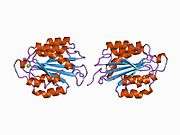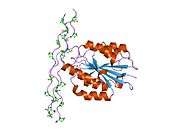CD49b
| View/Edit Human | View/Edit Mouse |
CD49b (cluster of differentiation 49b) is a protein which in humans is encoded by the CD49b gene.
The CD49b protein is an integrin alpha subunit. It makes up half of the α2β1 integrin duplex. Integrins are heterodimeric integral membrane glycoproteins composed of a distinct alpha chain and a common beta chain. They are found on a wide variety of cell types including, T cells (the NKT cells), NK cells, fibroblasts and platelets. Integrins are involved in cell adhesion and also participate in cell-surface mediated signalling.[3]
Expression of CD49b in conjunction with LAG-3 has been used to identify type 1 regulatory (Tr1) cells.[4]
DX5 is a monoclonal antibody which binds to CD49b.[5]
Interactions
CD49b has been shown to interact with MMP1.[6][7]
References
- ↑ "Human PubMed Reference:".
- ↑ "Mouse PubMed Reference:".
- ↑ "Entrez Gene: ITGA2 integrin, alpha 2 (CD49B, alpha 2 subunit of VLA-2 receptor)".
- ↑ Gagliani, Nicola; Magnani, Chiara F.; Huber, Samuel; Gianolini, Monica E.; Pala, Mauro; Licona-Limon, Paula; Guo, Binggege; Herbert, De'Broski R.; Bulfone, Alessandro (2013-06-01). "Coexpression of CD49b and LAG-3 identifies human and mouse T regulatory type 1 cells". Nature Medicine. 19 (6): 739–746. doi:10.1038/nm.3179. ISSN 1546-170X. PMID 23624599.
- ↑ Arase H, Saito T, Phillips JH, Lanier LL (August 2001). "Cutting edge: the mouse NK cell-associated antigen recognized by DX5 monoclonal antibody is CD49b (alpha 2 integrin, very late antigen-2)". Journal of immunology (Baltimore, Md. : 1950). 167 (3): 1141–4. doi:10.4049/jimmunol.167.3.1141. PMID 11466327.
- ↑ Stricker TP, Dumin JA, Dickeson SK, Chung L, Nagase H, Parks WC, Santoro SA (Aug 2001). "Structural analysis of the alpha(2) integrin I domain/procollagenase-1 (matrix metalloproteinase-1) interaction". J. Biol. Chem. 276 (31): 29375–81. doi:10.1074/jbc.M102217200. PMID 11359774.
- ↑ Dumin JA, Dickeson SK, Stricker TP, Bhattacharyya-Pakrasi M, Roby JD, Santoro SA, Parks WC (Aug 2001). "Pro-collagenase-1 (matrix metalloproteinase-1) binds the alpha(2)beta(1) integrin upon release from keratinocytes migrating on type I collagen". J. Biol. Chem. 276 (31): 29368–74. doi:10.1074/jbc.M104179200. PMID 11359786.
External links
- CD49b antigen at the US National Library of Medicine Medical Subject Headings (MeSH)
Further reading
- Moroi M, Jung SM (1997). "Platelet receptors for collagen.". Thromb. Haemost. 78 (1): 439–44. PMID 9198193.
- Takada Y, Kamata T, Irie A, Puzon-McLaughlin W, Zhang XP (1998). "Structural basis of integrin-mediated signal transduction.". Matrix Biol. 16 (4): 143–51. doi:10.1016/S0945-053X(97)90002-0. PMID 9402003.
- Dickeson SK, Santoro SA (1998). "Ligand recognition by the I domain-containing integrins.". Cell. Mol. Life Sci. 54 (6): 556–66. doi:10.1007/s000180050184. PMID 9676575.
- Porter JC, Hogg N (1999). "Integrins take partners: cross-talk between integrins and other membrane receptors.". Trends Cell Biol. 8 (10): 390–6. doi:10.1016/S0962-8924(98)01344-0. PMID 9789327.
- Plenz GA, Deng MC, Robenek H, Völker W (2003). "Vascular collagens: spotlight on the role of type VIII collagen in atherogenesis.". Atherosclerosis. 166 (1): 1–11. doi:10.1016/S0021-9150(01)00766-3. PMID 12482545.
- Charakida M, Tousoulis D, Stefanadis C, Toutouzas P (2003). "The impact of platelet glycoprotein IIIa and Ia polymorphisms in cardiovascular thrombotic disease.". Italian Heart Journal. 4 (1): 17–22. PMID 12690916.
- Tsantes AE, Nikolopoulos GK, Bagos PG, Vaiopoulos G, Travlou A (2007). "Lack of association between the platelet glycoprotein Ia C807T gene polymorphism and coronary artery disease: a meta-analysis.". Int. J. Cardiol. 118 (2): 189–96. doi:10.1016/j.ijcard.2006.06.047. PMID 17023078.
External links
- ITGA2 Info with links in the Cell Migration Gateway
This article is issued from Wikipedia - version of the 11/7/2016. The text is available under the Creative Commons Attribution/Share Alike but additional terms may apply for the media files.



